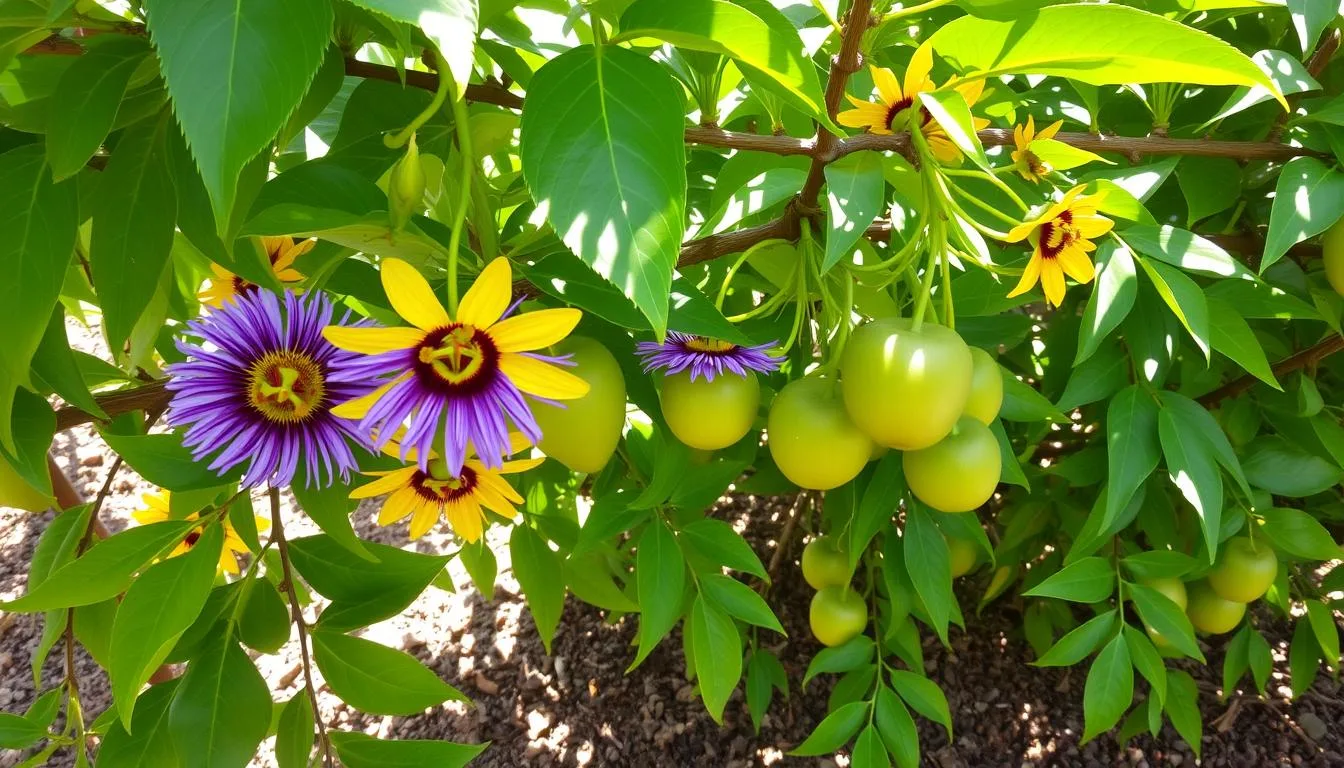Growing Passion Fruit Plant: A Complete Guide For Gardeners
Passion fruit is a tropical vine from the Passifloraceae family. It has edible fruits and beautiful flowers. Originally from South America, especially Brazil, it’s grown in many tropical places. Passion fruit vines can reach 30-40 feet high and wide. They’re great for trellises, fences, or pergolas.
The fruit is full of vitamins A and C, potassium, and more. It’s good for eating and has health benefits too.
Key Takeaways
- Passion fruit plants come in over 50 diverse varieties for growers to choose from.
- The Passiflora edulis species has a lifespan of about 5-7 years, with reduced fruit production after 3 years.
- Passion fruit vines are vigorous climbers, spreading 3-5 feet wide and growing 10-15 feet tall.
- Passion fruit typically blooms in early spring and produces fruit in approximately 80 days.
- Zones 10-12 are considered ideal for growing passion fruit outdoors.
Introduction to Passion Fruit Plants
Passion fruit plants are amazing vines that grow year after year. They have shiny leaves and tendrils that help them climb. Their flowers are big, with white and purple colors.
The main types are purple (Passiflora edulis) and yellow (Passiflora edulis flavicarpa). These are the most common passion fruits.
What is a Passion Fruit Plant?
Passion fruit plants come from the Passifloraceae family. This family has over 550 species. But, only one is called the passion fruit (Passiflora edulis).
These vines can grow really fast, up to 20 feet a year. They start to bear fruit in just one year after planting.
Benefits of Growing Passion Fruit
- Easy cultivation: Passion fruit plants are easy to grow, making them great for home gardens.
- Nutritious fruit: The fruit is sweet and full of vitamins, minerals, and antioxidants.
- Ornamental value: The flowers and leaves of passion fruit vines make gardens look beautiful and tropical.
Common Varieties of Passion Fruit
Some popular passion fruit varieties are:
- Frederick
- Nell Kelly
- Panama Red
- Black Knight
These varieties have fruits that are round or oval. They have a hard shell but the pulp inside is sweet and edible. The purple ones can pollinate themselves, but yellow ones need pollen from another vine.
“Passion fruit plants are a true delight for any gardener, offering a combination of easy care, nutritious fruit, and captivating visual appeal.”
Ideal Growing Conditions
Passion fruit plants need specific conditions to grow well. This includes the right climate, soil, and sunlight. Knowing what they need is key for a successful garden.
Climate Requirements
Passion fruit plants love warm, frost-free areas. They grow best in temperatures between 68°F and 75°F (20°C to 24°C). In cooler places, they can thrive indoors with lots of sunlight.
Soil Preferences
- They prefer well-drained, rich soil like sandy loam.
- The best soil pH is between 5.5 and 6.5. This helps them get the nutrients they need.
- Passion fruits don’t like salty soil or wet conditions.
Sunlight Needs
Passion fruit plants need lots of sunlight, except in very hot places. There, some shade helps avoid damage. Sunlight is essential for their growth and fruit production.
| Passion Fruit Growing Conditions | Ideal Range |
|---|---|
| Temperature | 68-75°F (20-24°C) |
| Soil pH | 5.5-6.5 |
| Sunlight Exposure | Full sun, with partial shade in very hot climates |
By meeting these conditions, gardeners can enjoy a great harvest. They’ll get to taste the delicious fruits of their hard work.
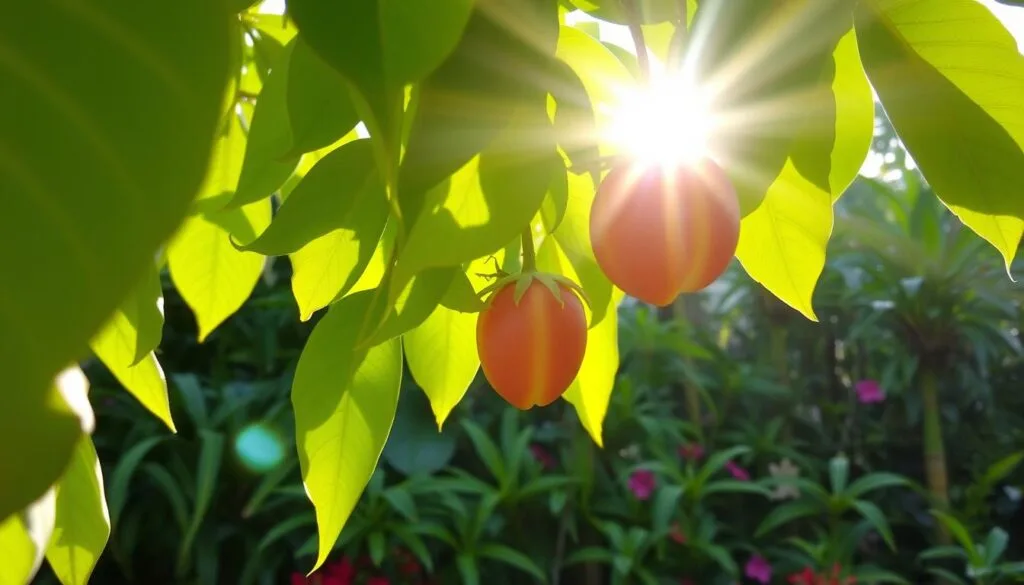
Planting Your Passion Fruit
Starting your passion fruit journey means picking the right materials. You can go for passion fruit seeds or seedlings. It’s key to get them from trusted sources for a strong start.
Selecting Seeds or Seedlings
For planting passion fruit, you can pick fresh seeds or strong seedlings. Purple and yellow passion fruits are popular. Seeds should come from quality, disease-free sources. Seedlings should be 6-8 inches tall and show healthy growth.
How to Prepare the Soil
Passion fruit loves well-drained, rich soil. Start by adding compost or aged manure to the soil. This boosts soil health and gives it nutrients. Make sure the soil drains well to avoid waterlogging and root rot.
Optimal Planting Techniques
When planting, dig a hole twice as wide as the root ball. Mix in kelp meal and bone meal for a nutrient boost. Place the seedling or seed-grown plant carefully, avoiding root damage. Create a water basin around the plant and use a trellis for support. For pots, choose ones that are at least 24 inches wide and deep.
“Passion fruit plants are heavy feeders and require a 5-5-10 fertilizer, with high potassium levels to encourage fruiting.”
By following these steps, you’ll be on your way to growing passion fruit. You’ll soon enjoy a rich harvest.
Watering and Fertilization
Proper watering and fertilization are key for your passion fruit plants to thrive. Passion fruit vines like Passiflora edulis ‘Frederick’ and P. edulis ‘Red Rover’ start producing fruit after a year or two. They can grow up to 30 feet tall under the right conditions. These plants love nitrogen and need deep, consistent watering, not shallow, frequent watering.
Watering Schedule
Passion fruit plants do best with deep, infrequent watering. This keeps the soil moist but not too wet. Water when the top inch of soil feels dry, making sure to soak the soil well. This helps the roots grow strong, which is vital for the plant’s health and fruit production.
Best Fertilizers for Passion Fruit
- Passion fruit vines grow best with nitrogen-rich fertilizers. A 10-5-20 N-P-K mix is good for commercial growers. Home gardeners can use a 5-7-5 or 6-6-6 blend.
- Young plants need a balanced fertilizer in early spring. This helps with root growth and keeps the leaves healthy.
- Foliar feeding with micronutrients like magnesium and boron should be done four times a year. This gives a nutrient boost.
Signs of Nutrient Deficiencies
Too much fertilizer can harm your plants, causing yellow leaves and stunted growth. It can also reduce flower and fruit production. Look out for signs of nutrient deficiencies like yellow leaves and poor fruiting. Adjusting your fertilization plan is important for your plants’ health.
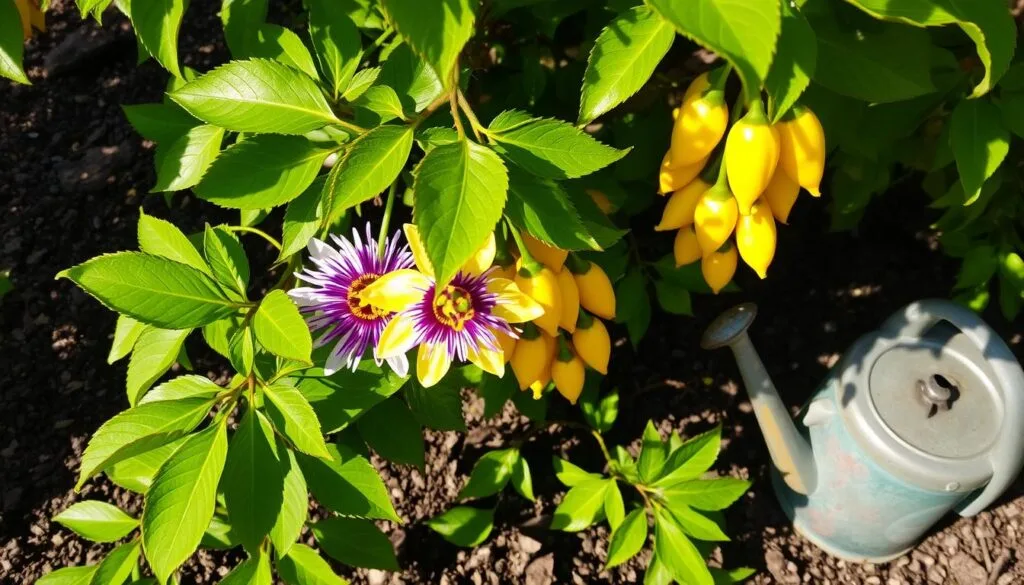
“Passion fruit vines require bees for pollination, leading to fruit production. For optimal growth and fruit production, passion fruit vines are heavy feeders and benefit from nitrogen-rich fertilizers.”
Pruning and Training Techniques
Keeping your passion fruit vines healthy and productive needs a smart pruning and training plan. Regular pruning helps shape the plant and boosts new growth, leading to more fruit. Timing is key for the best results in passion fruit cultivation.
When to Prune
Prune your passion fruit vines in early spring, right after the frost is gone. This is the best time for new growth and plant vigor. Cut back the vines by a third, removing dead, weak, or unproductive parts.
Training Your Passion Fruit Vine
- Train your passion fruit vines on trellises, fences, or pergolas to manage growth and make harvesting easier.
- Pick a strong shoot as the leader and regularly prune side shoots to keep the shape right.
- Support the vines well during the growing season for healthy growth and to avoid damage.
Common Pruning Mistakes to Avoid
- Don’t prune too much, as it can cut down fruit production and weaken the vine.
- Stay away from heavy pruning in cool climates or heavy soils, as it harms the plant’s health.
- Regular pruning and training are crucial for your passion fruit vines’ long-term success.
By following these tips for pruning passion fruit, training passion fruit vines, and passion fruit maintenance, you’ll get a great harvest and a thriving garden.
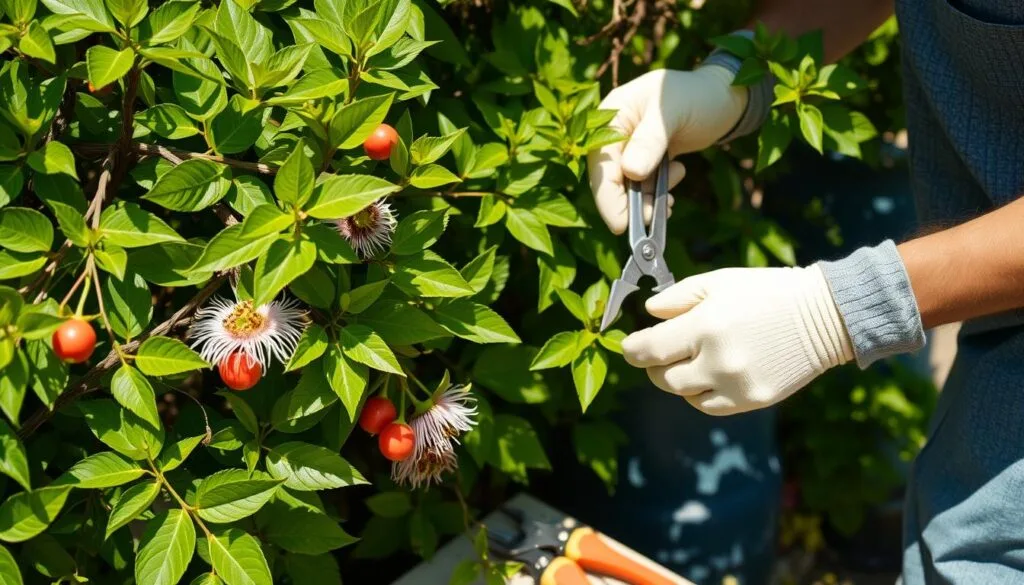
| Pruning Technique | Recommended Time | Purpose |
|---|---|---|
| Annual Pruning | Early Spring | Maintain productivity and shape |
| Thinning Side Shoots | Throughout Growing Season | Improve airflow and light exposure |
| Pruning Leaders | Regular Intervals | Encourage lateral growth and fruiting |
Pest and Disease Management
Passion fruit plants face many pests and diseases. These can harm their health and reduce their yield. It’s important for gardeners to watch out and use good strategies to fight these problems.
Common Pests Affecting Passion Fruit
Caterpillars, root-knot nematodes, and snails are common pests. They can damage leaves, roots, and fruits. This can hurt the plant’s growth and how much it produces.
Disease Prevention Strategies
Passion fruit plants can get diseases like woodiness virus and fusarium wilt. To stop these, make sure the soil drains well. Use disease-resistant roots and check your plants often for signs of disease.
Natural Remedies for Pests
- To control caterpillars, try neem oil or Bacillus thuringiensis (Bt).
- Keep the air moving to stop fungal diseases.
- Watch for aphids and remove any sick plants to stop disease from spreading.
Using these methods can keep your passion fruit plants healthy. This way, you won’t need to use harsh chemicals.
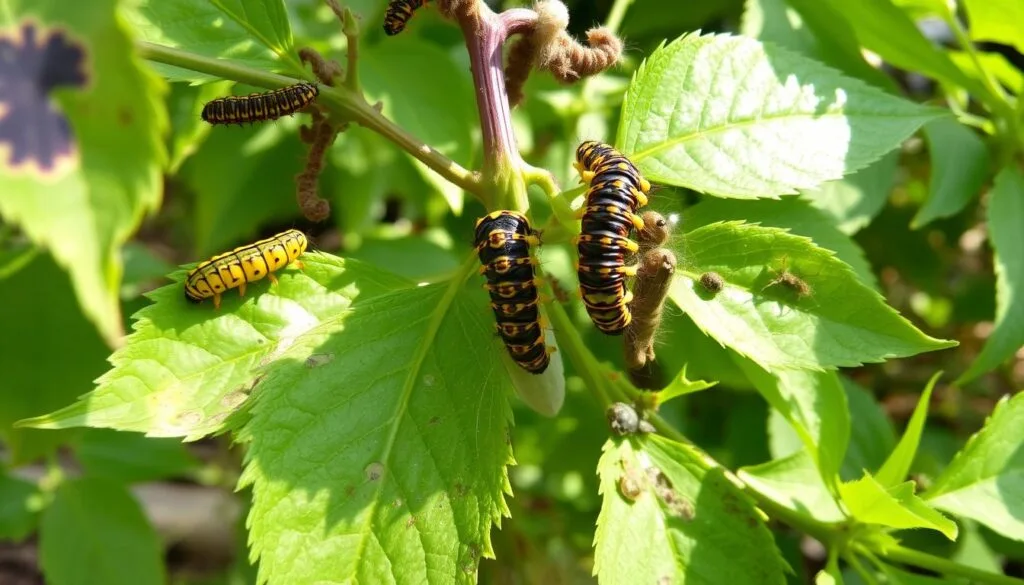
Harvesting Passion Fruit
Passion fruit is a tropical treat that’s sweet and tangy. Knowing when and how to harvest it is key. The purple variety ripens first, about 70 to 80 days after pollination. When it’s ready, the fruit will drop from the vine.
Signs of Ripe Passion Fruit
Ripe passion fruit has wrinkled skin and a deep purple or golden yellow color. Purple ones turn from green to reddish-purple. Yellow ones turn golden. Shake the fruit gently – if it rattles, it’s ready.
How to Properly Harvest
- Harvest passion fruit by hand-picking or collecting fallen fruit from the ground.
- Avoid crushing or bruising the fruit during harvest, as this can lead to spoilage.
- Use clean, dry hands or gardening gloves to handle the fruit.
- Gently twist and pull the fruit from the vine, leaving a small stem attached.
Post-Harvest Care
After harvesting, passion fruit can be stored at room temperature for up to a week. Or refrigerated for 2-3 weeks. Its flavor gets better a few days after picking. For longer storage, growers coat it in paraffin for up to 30 days.
| Passion Fruit Variety | Bloom Time | Ripening Time | Storage Life |
|---|---|---|---|
| Purple | March – April | 70-80 days | Up to 1 week at room temp, 2-3 weeks refrigerated |
| Yellow | April – November | 70-80 days | Up to 1 week at room temp, 2-3 weeks refrigerated |
By knowing when passion fruit is ripe and how to store it, you can enjoy its flavor for weeks.

Tips for Successful Passion Fruit Growth
Passion fruit plants are a joy to have in your garden. But, they need special care to grow well. We’ll look at how to choose the right companion plants, seasonal tasks, and how to fix common problems.
Companion Planting Recommendations
Planting herbs like basil or marigolds with passion fruit vines is smart. They keep pests away and attract good bugs. Passion fruit vines also do well near a trellis or wall. This gives them support and protects them from frost.
Seasonal Care Tasks
- Mulch around the base of the plants to keep moisture in and weeds out.
- Use a balanced, slow-release fertilizer to feed your passion fruit vines.
- Water more often when it’s hot and dry.
Troubleshooting Common Issues
Even experienced growers face challenges. Here are some common problems and how to fix them:
- Poor fruit set: It might be because of bad pollination. Try hand-pollinating or attract more pollinators.
- Leaf yellowing: Yellow leaves mean you might need more nutrients. Check your fertilizer.
- Vine dieback: This could be disease or stress. Watch your plant closely and fix the problem.
By following these tips and watching for problems, you’ll grow a healthy passion fruit plant. It will give you plenty of fruit every season.
Conclusion and Encouragement for Gardeners
Growing passion fruit can be very rewarding for gardeners. It’s important to know what these tropical vines need. Focus on climate, soil, watering, and care to enjoy a good harvest of these tasty fruits.
Summary of Key Points
Successful passion fruit growing means giving them full sun and well-draining soil. The soil should have a pH of 5.5 to 6.5. Also, keep the soil moist and prune the vines regularly. Choose disease-resistant varieties and be patient for the best results.
Final Tips for New Growers
New passion fruit growers should pick the right varieties for their area. Maypops (Passiflora incarnata) can grow in cooler zones, while yellow passion fruit prefers warmer places. With care and patience, even beginners can enjoy fresh passion fruit.
Join the Passion Fruit Community
Start your passion fruit journey by joining local gardening groups or online forums. Passion fruit lovers are always ready to share tips and advice. This community can help you find new varieties, solve problems, and keep improving your gardening skills.


